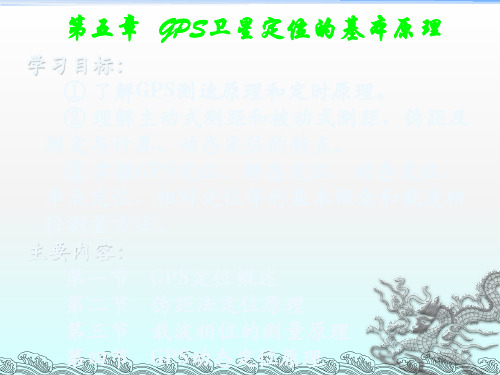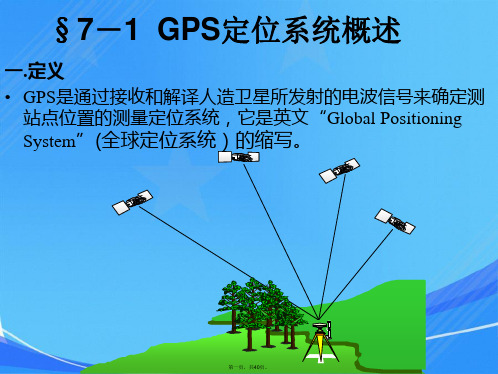GPS理论与应用--伪随机码测距原理 ppt课件
合集下载
《GPS定位原理》PPT课件_OK

❖ 定位速度快,实时定位 ❖ 可提高测距精度 ❖ 对信号的强度要求不高,易于捕获
微弱的卫星信号 ❖ 采用的是CDMA(码分多址)技术 ❖ 便于对系统进行控制和管理
2021/8/20
27
5.2.2 伪距测量定位原理
伪距测量的观测方程
码相关法测量伪距时,有一个基本假设,即卫星
钟和接收机钟是完全同步的。但实际上这两台钟之间
49
某一瞬间的载波相位测量值指的是该瞬间 接收机所产生的基准信号的相位(b) 和接收到 的来自卫星的载波信号的相位(a) 之差。因此, 根据某一瞬间的载波相位测量值可求出该瞬间 从卫星到接收机的距离。
❖ GPS的测距码 C/A码:码速1.023MHz, TP=1ms, LP=1023, 码元长度293.052m
2021/8/20Fra bibliotek20P码: 码速10.23MHz,
TP=266天9小时45分55.5秒, LP=235469592765000, 码元长度29.3052m。
实际被截为7天一个周期,共38段,每 一段赋予不同的卫星,卫星的PRN号也由此 得到。
伪距测量(伪距法定位) 载波相位测量
❖ 依定位时效
实时定位 事后定位
❖ 依确定整周模糊度的方法及观测时段的长短:
常规静态定位 快速静态定位
2021/8/20
4
5.1.1静态定位和动态定位
❖ 静态定位
在定位过程中,接收机的位置是固定的,处 于静止状态。这种静止状态是相对的。在卫星大 地测量学中,所谓静止状态,通常是指待定点的 位置,相对其周围的点位没有发生变化,或变化 极其缓慢,以致在观测期内(数天或数星期)可 以忽略。
2021/8/20
12
2021/8/20
微弱的卫星信号 ❖ 采用的是CDMA(码分多址)技术 ❖ 便于对系统进行控制和管理
2021/8/20
27
5.2.2 伪距测量定位原理
伪距测量的观测方程
码相关法测量伪距时,有一个基本假设,即卫星
钟和接收机钟是完全同步的。但实际上这两台钟之间
49
某一瞬间的载波相位测量值指的是该瞬间 接收机所产生的基准信号的相位(b) 和接收到 的来自卫星的载波信号的相位(a) 之差。因此, 根据某一瞬间的载波相位测量值可求出该瞬间 从卫星到接收机的距离。
❖ GPS的测距码 C/A码:码速1.023MHz, TP=1ms, LP=1023, 码元长度293.052m
2021/8/20Fra bibliotek20P码: 码速10.23MHz,
TP=266天9小时45分55.5秒, LP=235469592765000, 码元长度29.3052m。
实际被截为7天一个周期,共38段,每 一段赋予不同的卫星,卫星的PRN号也由此 得到。
伪距测量(伪距法定位) 载波相位测量
❖ 依定位时效
实时定位 事后定位
❖ 依确定整周模糊度的方法及观测时段的长短:
常规静态定位 快速静态定位
2021/8/20
4
5.1.1静态定位和动态定位
❖ 静态定位
在定位过程中,接收机的位置是固定的,处 于静止状态。这种静止状态是相对的。在卫星大 地测量学中,所谓静止状态,通常是指待定点的 位置,相对其周围的点位没有发生变化,或变化 极其缓慢,以致在观测期内(数天或数星期)可 以忽略。
2021/8/20
12
2021/8/20
精品课程GPS原理及应用-第4章 GPS卫星定位原理ppt课件

GPS载波相位测量的基本原理
在某一时刻ti,卫星信号的相位等于本机振
荡器产生的基准相位:
;相同
时刻接收的GPS卫星信号的载波相位为
,那么
因此,信号传播距离为
由于卫星与地球间的相对运动,接收的
卫星信号的频率因多普勒频移而产生变化, 与基准信号频率不同。
将接收的卫星信号与产生的基准信号混频, 得到差频的中频信号,其相位值即为2个信号间 的相位差。因此通过测定该中频信号的相位便可 获得所需的相位差。
上式可以表示为
与伪距观测方程相同,测站与卫星之间的几
何距离也是坐标的非线性函数。同样,可取
测站坐标的近似值
,将其线性化后
有
将上式带入到
得线性化的载波相位观测方程为
机钟面时 收到卫星信号后产生的基准信
号相位为 。这时相应于历元t的相位观
测量 ,应当等于接收机基准信号相位
与卫星发射信号相位之差减去相应于初始
历元t0的相位差整周数
。即有
式中: 称为整周未知数〔或整周模糊 度)。
卫星钟和接收机钟0.0016HZ~0.016HZ。由于信号由
用距离交会的方法求解P点的三维坐标 〔x,y,z〕的观测方程为:
(j=1,2,3,4)
在GPS定位中,GPS卫星是高速运动 的卫星,其坐标值随时间在快速变化着。 需要实时地由GPS卫星信号测量出测站至 卫星之间的距离,实时地由卫星的导航电 文解算出卫星的坐标值,并进行测站点的 定位。
距离测量主要采用2种方法:一种方 法是测量GPS卫星发射的测距码信号达到 用户接收机的传播时间,即伪距测量;另 一种方法是测量具有载波多普勒频移的 GPS卫星载波信号与接收机产生的参考载 波信号之间的相位差,即载波相位测量。 通过对4颗或4颗以上的卫星同时进行伪距 或相位的测量,即可推算出接收机的三维 位置。采用伪距观测量定位速度相对较快, 而采用载波相位观测量定位精度相对较高。
GPS概论第五章GPS卫星定位基本原理PPT课件

线性化后:
i
X ( 0 0)x ii dX Y(0 0)yii dY Z (0 0)zii dZ (0)i NctV RctV S (Vio)niVtrop
x(i0X )i0dX y(i 0)Yi0dY z(i0Z )i0dZ (0)iNctV RctV S (Vio)niVtrop
误差方程为:
• 定义
– 单独利用一台接收机确定待定点在地固坐标系中绝对位 置的方法
• 定位结果-与所用星历同属一坐标系的绝对坐标
– 采用广播星历时属WGS-84
– 采用IGS – International GPS Service精密星历时为 ITRF – International Terrestrial Reference Frames
~ N 0 Int ( ) Fr ( )
• 整周计数 Int
载波相位观测值
• 整周未知数(整周模糊度) N 0
19
载波相位测量的观测方程
原始形式:
(iN i) ictR V ctS V (V i o)in V trop i iN i ictR V ctS V (V i o)in V trop
接收机根据自身 的 钟 在 tR时 刻 所 接 收 到 卫 星 在 tS 时刻所发送信号 的相位
(tS)
tR tS
R
R
理想情况
实际情况
18
载波相位观测值 ti
• 观测值
Fr i Int() i N 0
首次观测:
0 Fr ( ) 0
t0
以后的观测:
Fr 0 N0
i Int ( ) i Fr ( ) i 通常表示为:
载波波长为原来波长的一半,信 号质量较差(信噪比低,降低了 30dB)
GPS卫星定位原理及其应用.ppt课件

初相角 角频率 振幅
10/20/2023
7
电磁波传播中常用公式的转换
10/20/2023
8
大气层对电磁波传播的影响
根据电磁波传播的不同影响,一般可将大气层分为: 1.对流层
系指从地面上约40Km范围内的大气底层。 对流层具有很强的对流作用,云、雾、雨、雪、风
等主要天气现象,均出现在其中,这些对电磁波的
11
电离层改正模型
10/20/2023
12
减弱电离层影响的措施
1.利用两种不同的频率进行观测
2.两观测站同步观测量求差
10/20/2023
13
GPS卫星的测距码信号
GPS卫星所发射的信号包括: 载波信号 P码(或Y码) C/A码 数据码(又称作D码)
其中:C/A码和P码统称为测距码。
10/20/2023
基准频率 10.23 MHz
x 154 x 120
/10
L1
C/A 码
1575.42 MHz 1.023 MHz
P (Y) 码 10.23 MHz
L2 1227.60 MHz
P (Y)-Code 10.23 MHz
50 bit/s
卫星信悉( 状态信悉和星历)
10/20/2023
17
载波相位测距
载波相位观测
14
GPS卫星信号的产生与构成的要求
1.适应多用户系统的要 求
2.满足实时定位的要求 3.满足高度定位的要
求 4.满足军事保密的要求
10/20/2023
15
GPS卫星的导航电文(数据码)
导航电文主要包括: 1.与卫星有关的星 历 2.卫星的工作状态 3.时间系统 4.卫星钟运行状态 5.轨道摄动改正 6.大气摄动改正 7.导航信息的数据 码
10/20/2023
7
电磁波传播中常用公式的转换
10/20/2023
8
大气层对电磁波传播的影响
根据电磁波传播的不同影响,一般可将大气层分为: 1.对流层
系指从地面上约40Km范围内的大气底层。 对流层具有很强的对流作用,云、雾、雨、雪、风
等主要天气现象,均出现在其中,这些对电磁波的
11
电离层改正模型
10/20/2023
12
减弱电离层影响的措施
1.利用两种不同的频率进行观测
2.两观测站同步观测量求差
10/20/2023
13
GPS卫星的测距码信号
GPS卫星所发射的信号包括: 载波信号 P码(或Y码) C/A码 数据码(又称作D码)
其中:C/A码和P码统称为测距码。
10/20/2023
基准频率 10.23 MHz
x 154 x 120
/10
L1
C/A 码
1575.42 MHz 1.023 MHz
P (Y) 码 10.23 MHz
L2 1227.60 MHz
P (Y)-Code 10.23 MHz
50 bit/s
卫星信悉( 状态信悉和星历)
10/20/2023
17
载波相位测距
载波相位观测
14
GPS卫星信号的产生与构成的要求
1.适应多用户系统的要 求
2.满足实时定位的要求 3.满足高度定位的要
求 4.满足军事保密的要求
10/20/2023
15
GPS卫星的导航电文(数据码)
导航电文主要包括: 1.与卫星有关的星 历 2.卫星的工作状态 3.时间系统 4.卫星钟运行状态 5.轨道摄动改正 6.大气摄动改正 7.导航信息的数据 码
GPS原理与应用PPT课件

来适应车队管理的需要。
18
最近,越来越多普通消费者买得起的GPS接收器出 现了。随着技术的进步,这些设备的功能越来越完 善,几乎每月都有新的功能出现,但价格在下跌, 尺寸也越来越小了。
消费类GPS手持机的价格从几百元到几千元不等, 它们基本上都有12个并行通道和数据功能。有些甚 至能与便携电脑相连,可以上传/下载GPS信息,并 且使用精确到街道级的地图软件,可以在PC的屏幕 上实时跟踪你的位置或自动导航。
29
6.信号干扰
要给予你一个很好的定位,GPS接收器需要至少 3~5颗卫星是可见的。如果你在峡谷中或者两边高 楼林立的街道上,或者在茂密的丛林里,你可能不 能与足够的卫星联系,从而无法定位或者只能得到 二维坐标。同样,如果你在一个建筑里面,你可能 无法更新你的位置,一些GPS接收器有单独的天线可 以贴在挡风玻璃上,或者一个外置天线可以放在车 顶上,这有助于你的接收器得到更多的卫星信号。
Colorado springs
5 5
Hawaii
Ascencion
Diego Garcia
kwajalein
9
3.GPS信号接收机 GPS 信号接收机的任务是:能够捕获到按
一定卫星高度截止角所选择的待测卫星的信号, 并跟踪这些卫星的运行,对所接收到的GPS信号 进行变换、放大和处理,以便测量出GPS信号从 卫星到接收机天线的传播时间,解译出GPS卫星 所发送的导航电文,实时地计算出测站的三维位 置,甚至三维速度和时间。
在商业领域,消费类GPS主要用在勘测制图, 航空、航海导航,车辆追踪系统,移动计算机 和蜂窝电话平台等方面。
17
勘测制图由一系列的定位系统组成,一般都要求 特殊的GPS设备。
在勘测方面的应用 有:结构和工程勘测、道路测 量和地质研究。收集到的数据可以以后再估算, 也可以在 野外实时使用。制图过程中使用大量的 GIS数据库的数据,还有纸质地图的数据。 许多 商业和政府机构使用GPS设备来跟踪他们的车辆 位置,这一般需要借助无线通信技术。一 些GPS 接收器集成了收音机、无线电话和移动数据终端
18
最近,越来越多普通消费者买得起的GPS接收器出 现了。随着技术的进步,这些设备的功能越来越完 善,几乎每月都有新的功能出现,但价格在下跌, 尺寸也越来越小了。
消费类GPS手持机的价格从几百元到几千元不等, 它们基本上都有12个并行通道和数据功能。有些甚 至能与便携电脑相连,可以上传/下载GPS信息,并 且使用精确到街道级的地图软件,可以在PC的屏幕 上实时跟踪你的位置或自动导航。
29
6.信号干扰
要给予你一个很好的定位,GPS接收器需要至少 3~5颗卫星是可见的。如果你在峡谷中或者两边高 楼林立的街道上,或者在茂密的丛林里,你可能不 能与足够的卫星联系,从而无法定位或者只能得到 二维坐标。同样,如果你在一个建筑里面,你可能 无法更新你的位置,一些GPS接收器有单独的天线可 以贴在挡风玻璃上,或者一个外置天线可以放在车 顶上,这有助于你的接收器得到更多的卫星信号。
Colorado springs
5 5
Hawaii
Ascencion
Diego Garcia
kwajalein
9
3.GPS信号接收机 GPS 信号接收机的任务是:能够捕获到按
一定卫星高度截止角所选择的待测卫星的信号, 并跟踪这些卫星的运行,对所接收到的GPS信号 进行变换、放大和处理,以便测量出GPS信号从 卫星到接收机天线的传播时间,解译出GPS卫星 所发送的导航电文,实时地计算出测站的三维位 置,甚至三维速度和时间。
在商业领域,消费类GPS主要用在勘测制图, 航空、航海导航,车辆追踪系统,移动计算机 和蜂窝电话平台等方面。
17
勘测制图由一系列的定位系统组成,一般都要求 特殊的GPS设备。
在勘测方面的应用 有:结构和工程勘测、道路测 量和地质研究。收集到的数据可以以后再估算, 也可以在 野外实时使用。制图过程中使用大量的 GIS数据库的数据,还有纸质地图的数据。 许多 商业和政府机构使用GPS设备来跟踪他们的车辆 位置,这一般需要借助无线通信技术。一 些GPS 接收器集成了收音机、无线电话和移动数据终端
《GPS卫星定位原理》PPT课件

静态定位与动态定位的不同点
静态定位
动态定位
可靠性强,定位精度 高,在大地测量、工 程测量中得到了广泛 的应用,是精密定位 中的基本模式。
可测定一个动点 的实时位置、运 动载体的状态参 数。如速度、时 间和方位等。
二、单点定位与相对定位
1. 单点定位(绝对定位) 独立确定待定点在坐标系中的绝对位置的方法称为单点定位或绝对定位。由
均为已知值。待定点P即为需要确定的船舶位置。用户用专用的无线电接收机按被
动式测距方式测定了至A点的距离RA和至B点的距离RB。于是我们就能根据以A为 圆心,以RA为半径的定位圆和以B为圆心以RB为半径的定位圆交出待定点P的位置.
A (圆心)
B(圆心)
当然两圆相交一般有两个交点,但根据待定点的概略位置通常是不难加以判断 和取舍的。而且为了提高解的精度和可靠性,实际上使用的已知信号发射台也往 往不止两个。也就是说实际上我们往往是从三个或三个以上已知点来交会P点的。 在这种情况下便不再存在多值性问题。
后到达接收机,接收机在自己的时钟控制下产生一组结构完全相同的测距码(复制 码),并通过时延器使其延迟时间 。将这两组测距码进行相关处理,若自相关系
数已和接收,到则的继来续自调卫整星延的迟测时距间码对,齐直,到复自制相t码关的系延数迟时间或趋就近等于于1卫为星止信。号此的时传复播制时码
间 。 将 乘 上光速c后即可求得卫星至接收机的伪距。
播时间 ,它还包含了两台钟不同步的影响在内。此外,由于信号并不是完全在真
空中传播的,因而观测值 中也包含了大气传播延迟误差。在伪距测量中,一般把
在
的条件下求得的时延 和真空中的光速c的乘积 当作观测值,下面我
们将建立卫星与接收机之间R(的t) 几 m何a距x 离 与观测值 之间的关系式。
卫星定位理论与方法-第13次课-伪随机码测距原理45页PPT

xiexie! 38、我这个人走得很慢,但是我从不后退。——亚伯拉罕·林肯
39、勿问成功的秘诀为何,且尽全力做你应该做的事吧。——美华纳
40、学而不思则罔,思而不学则殆。——孔子
卫星定位理论与方法-第13次 课-伪随机码测距原理
41、实际上,我们想要的不是针对犯 罪的法 律,而 是针对 疯狂的 法律。 ——马 克·吐温 42、法律的力量应当跟随着公民,就 像影子 跟随着 身体一 样。— —贝卡 利亚 43、法律和制度必须跟上人类思想进 步。— —杰弗 逊 44、人类受制于法律,法律受制于情 理。— —托·富 勒
45、法律的制定是为了保证每一个人 自由发 挥自己 的才能 ,而不 是为了 束缚他 的才能 。—— 罗伯斯 庇尔
谢谢!
36、自己的鞋子,自己知道紧在弱。——拉罗什福科
GPS原理及应用PPT课件

• 该系统由5个监测站、1个主控站和3个注入站组成,设在美 国本土的科罗拉多和三大洋的美国军事基地中。
Colorado springs
55
Hawaii
Ascencion
Diego Garcia
kwajalein
一个主控站:科罗拉多•斯必灵司 三个注入站:阿松森(Ascencion)、迭哥•伽西亚(Diego Garcia)和卡瓦
• GPS静态定位方法主要用于建立各级测量控制网,其优点 如下:
• 定位精度高,其基线的相对精度非常高 • 选点灵活、不需要造标、费用低
• 可全天候作业
• 观测处理自动化
• GPS测量工作包括控制网设计、选点埋石、野外观测和内业处 理等。
第二十九页,共40页。
一. 构建GPS控制网(网形设计、选点埋石)
2.网形设计
• 根据不同的用途,GPS网的基本形式有点连式、边连式、网 连式和边点混合连接四种(见教材P204~205)。除点连式 外,其它形式的GPS网形应用都较多。
• GPS网的设计原则
• 应通过独立观测边构成闭合图形,以增加检核条件,提高网的 可靠性。
• 应尽量与原有地面控制网相重合,重合点一般不少于3个, 且分布均匀。
第四页,共40页。
• GPS卫星的主要功能
• 连续不断地向地球发送 导航定位的GPS信号, 以导航电文的形式向用 户提供卫星星历表(其 中包含卫星现时的位置 及其它卫星的概略位 置)、时钟校正参数、 传播延迟参数及其它信 息。
(最主要的信息是“时间” 和“位置”)
第五页,共40页。
2.地面监控系统
相对定位?相对定位是通过测量卫星发送的电波到达两台接收机的时间差来完成的用两台同类型的接收机同步跟踪相同的4颗卫星信号对两台接收机接收到的电波信号作合成处理即可求出接收机之间的相对位置三维坐标差或基线向量只要给出了一个站点的坐标便能求得另一点的坐标
Colorado springs
55
Hawaii
Ascencion
Diego Garcia
kwajalein
一个主控站:科罗拉多•斯必灵司 三个注入站:阿松森(Ascencion)、迭哥•伽西亚(Diego Garcia)和卡瓦
• GPS静态定位方法主要用于建立各级测量控制网,其优点 如下:
• 定位精度高,其基线的相对精度非常高 • 选点灵活、不需要造标、费用低
• 可全天候作业
• 观测处理自动化
• GPS测量工作包括控制网设计、选点埋石、野外观测和内业处 理等。
第二十九页,共40页。
一. 构建GPS控制网(网形设计、选点埋石)
2.网形设计
• 根据不同的用途,GPS网的基本形式有点连式、边连式、网 连式和边点混合连接四种(见教材P204~205)。除点连式 外,其它形式的GPS网形应用都较多。
• GPS网的设计原则
• 应通过独立观测边构成闭合图形,以增加检核条件,提高网的 可靠性。
• 应尽量与原有地面控制网相重合,重合点一般不少于3个, 且分布均匀。
第四页,共40页。
• GPS卫星的主要功能
• 连续不断地向地球发送 导航定位的GPS信号, 以导航电文的形式向用 户提供卫星星历表(其 中包含卫星现时的位置 及其它卫星的概略位 置)、时钟校正参数、 传播延迟参数及其它信 息。
(最主要的信息是“时间” 和“位置”)
第五页,共40页。
2.地面监控系统
相对定位?相对定位是通过测量卫星发送的电波到达两台接收机的时间差来完成的用两台同类型的接收机同步跟踪相同的4颗卫星信号对两台接收机接收到的电波信号作合成处理即可求出接收机之间的相对位置三维坐标差或基线向量只要给出了一个站点的坐标便能求得另一点的坐标
伪距定位原理.ppt

2. 伪距定位观测方程
The Observation Equations
2.1 真实的信号传播时延
Tj
j Tr T j
问 题
Tr
真实的信号传播时延能够直接获取吗?
2. 伪距定位观测方程
The Observation Equations
2.2 钟差
钟差(Clock Bias):卫星、接收机钟面时与卫星导航系统时之差
1. 相关知识回顾
Review
1.1 空间距离后方交会原理
GPS的定位体制:“多星、高轨、测距”
利用空间距离后方交会确定接收机的位置
(X 2,Y 2,Z2)
(X 3,Y3,Z3)
(X1,Y1, Z1)
(X 4,Y 4,Z4)
(X ,Y , Z )
1. 相关知识回顾
Review
1.2 卫星位置计算
tr tr Tr
t j t j T j
toc、a0、a1、a2
2. 伪距定位观测方程
The Observation Equations
2.3 信号传播时延
真实的信号传播时延:
j Tr T j
实测的信号传播时延:
%j tr t j
tj T j tj tr Tr tr
%j (Tr tr ) (T j t j )
l j X m jY n j Z ctr 0j %j ct j I j T j
小结 Summary
伪距定位原理是《GPS原理与应用》的核心内容,主要介绍 了伪距定位观测方程的建立和伪距定位观测方程的解,得到了必 须同时观测4颗卫星才能进行定位的结论。
作业题
1.利用GPS进行伪距定位,为什么必须至少同时观测4颗卫星? 2.如何利用GPS伪距定位观测方程解算用户位置?
- 1、下载文档前请自行甄别文档内容的完整性,平台不提供额外的编辑、内容补充、找答案等附加服务。
- 2、"仅部分预览"的文档,不可在线预览部分如存在完整性等问题,可反馈申请退款(可完整预览的文档不适用该条件!)。
- 3、如文档侵犯您的权益,请联系客服反馈,我们会尽快为您处理(人工客服工作时间:9:00-18:30)。
(3)大气衰减小,有利于研制用户设备。GPS卫星采 用L波段,避开了大气的谐振吸收,衰减较小,且电 离层延迟的影响小,有利于用较经济的接收设备测 量GPS信号。而采用两个载频,目的在于测量出或 消除掉由于电离层效应而引起的延迟误差。
GPS理论与应用
5.伪随机码测距原理
When a radio transmits a signal, it is in the form of a simple sine wave that has a particular frequency (the number of “humps” on the sine wave that pass a fixed point per unit of time-usually given as Hertz, or times per second), wavelength (the distance between “humps” or any matching successive point on the sine wave), and amplitude (the “height” of the “humps”).
This simply means that the carrier signal is modulated (varied) by changing its phase (updown position of the waves) back and forth (biphase) at a regular and programmed rate and interval.
载频作载波,分别被称作L1的主频率和 L2的次频率。
这些载波频率由扩频码(每一颗卫星均 有专门的伪随机序列)和导航电文所调
制。所有卫星均在这两个相同的载波频 率上发射,但由于伪随机码调制不同, 因此无明显的相互干扰。
GPS理论与应用 5.伪随机码测距原理
GPS理论与应用
5.伪随机码测距原理
Each satellite transmits its ranging signal on two different radio frequencies: 1575.42 Megahertz (pБайду номын сангаасrt of the so-called “L-Band”) which is referred to as the L1 Carrier, and 1227.60 Megahertz (also of the L-Band) designated as the L2 Carrier.
There are two different pseudo-random code strings used by the GPS: the Coarse Acquisition Code (C/A-code), sometimes called the “Civilian Code” , and the Precise, or Protected Code (P-Code).
A basic carrier sine wave is illustrated at the top of the diagram.
Radio wavelengths can range from tens of kilometers down to tiny fractions of micrometer. Frequencies, intrinsically linked to wave-lengths, also have wide ranges, from only a few per hour (low frequency) to billions per second (high frequency).
GPS理论与应用 5.伪随机码测距原理
This modulation of the signal, which is really just a series of “dots and dashes,” is very long and complicated. So complicated, in fact, that if you were just to look at it without knowing what it was, it would simply look like a bunch of random noise that made no sense at all. But it really does make sense to those in the know. Thus the term pseudo-random noise.
GPS理论与应用 5.伪随机码测距原理
选择L波段的优点是:
(1) 减少拥挤,避免“撞车”。目前L波段的频率占 用率低于其他波段,与其他工作频率不易发生“撞 车”现象,有利于全球性的导航定位测量。
(2) 适应扩频,传送宽带信号。GPS卫星采用扩频技 术发送卫星导航电文,其频带高达20 MHz左右,在 占用率较低的L波段上, 易于传送扩频后的宽带信号。
Superimposed on these radio carrier wave signals are pseudo-random, binary, bi-phase modulation codes called PRN (Pseudo Random Noise) codes that are unique to each individual satellite.
GPS理论与应用
(5.伪随机码测距原理)
GPS理论与应用 5.伪随机码测距原理
授课内容 1.GPS卫星的测距码信号 2.GPS测距原理 3.伪随机码基础 4.GPS中的伪码扩频 5.伪随机码测距原理
GPS理论与应用 5.伪随机码测距原理
1.GPS卫星的测距码信号
GPS卫星发送的信号采用L波段的两种
GPS理论与应用
5.伪随机码测距原理
When a radio transmits a signal, it is in the form of a simple sine wave that has a particular frequency (the number of “humps” on the sine wave that pass a fixed point per unit of time-usually given as Hertz, or times per second), wavelength (the distance between “humps” or any matching successive point on the sine wave), and amplitude (the “height” of the “humps”).
This simply means that the carrier signal is modulated (varied) by changing its phase (updown position of the waves) back and forth (biphase) at a regular and programmed rate and interval.
载频作载波,分别被称作L1的主频率和 L2的次频率。
这些载波频率由扩频码(每一颗卫星均 有专门的伪随机序列)和导航电文所调
制。所有卫星均在这两个相同的载波频 率上发射,但由于伪随机码调制不同, 因此无明显的相互干扰。
GPS理论与应用 5.伪随机码测距原理
GPS理论与应用
5.伪随机码测距原理
Each satellite transmits its ranging signal on two different radio frequencies: 1575.42 Megahertz (pБайду номын сангаасrt of the so-called “L-Band”) which is referred to as the L1 Carrier, and 1227.60 Megahertz (also of the L-Band) designated as the L2 Carrier.
There are two different pseudo-random code strings used by the GPS: the Coarse Acquisition Code (C/A-code), sometimes called the “Civilian Code” , and the Precise, or Protected Code (P-Code).
A basic carrier sine wave is illustrated at the top of the diagram.
Radio wavelengths can range from tens of kilometers down to tiny fractions of micrometer. Frequencies, intrinsically linked to wave-lengths, also have wide ranges, from only a few per hour (low frequency) to billions per second (high frequency).
GPS理论与应用 5.伪随机码测距原理
This modulation of the signal, which is really just a series of “dots and dashes,” is very long and complicated. So complicated, in fact, that if you were just to look at it without knowing what it was, it would simply look like a bunch of random noise that made no sense at all. But it really does make sense to those in the know. Thus the term pseudo-random noise.
GPS理论与应用 5.伪随机码测距原理
选择L波段的优点是:
(1) 减少拥挤,避免“撞车”。目前L波段的频率占 用率低于其他波段,与其他工作频率不易发生“撞 车”现象,有利于全球性的导航定位测量。
(2) 适应扩频,传送宽带信号。GPS卫星采用扩频技 术发送卫星导航电文,其频带高达20 MHz左右,在 占用率较低的L波段上, 易于传送扩频后的宽带信号。
Superimposed on these radio carrier wave signals are pseudo-random, binary, bi-phase modulation codes called PRN (Pseudo Random Noise) codes that are unique to each individual satellite.
GPS理论与应用
(5.伪随机码测距原理)
GPS理论与应用 5.伪随机码测距原理
授课内容 1.GPS卫星的测距码信号 2.GPS测距原理 3.伪随机码基础 4.GPS中的伪码扩频 5.伪随机码测距原理
GPS理论与应用 5.伪随机码测距原理
1.GPS卫星的测距码信号
GPS卫星发送的信号采用L波段的两种
